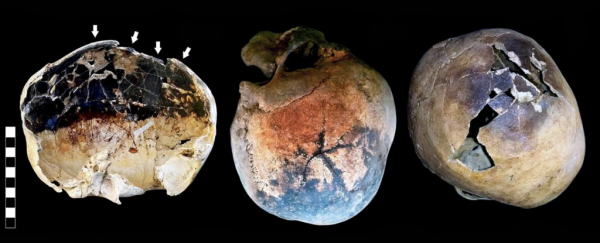In August of the year 79 CE, the surrounds of volcano Mount Vesuvius were definitely not the place to be. Over the two days of a catastrophic eruption, if pyroclastic surges didn't roast you alive, any number of other things could have made for a horrific death.
Including, according to new research, this exciting death: the heat vaporising all your bodily fluids, which then causes steam pressure to explode your skull from the inside.
Archaeologists at the Federico II University Hospital in Italy have conducted a study of bones recovered from 12 ash-filled waterfront chambers in Herculaneum - one of the cities closest to the volcano - and discovered a strange, red and black mineral residue on the bones, including inside skulls, and permeating the ash around and inside the skeletons.
According to inductively coupled plasma mass spectrometry and Raman microspectroscopy analyses, that residue contains iron and iron oxides. Which is what would happen when blood boils and turns into steam.
"Here we show for the first time convincing experimental evidence suggesting the rapid vaporisation of body fluids and soft tissues of the 79 AD Herculaneum victims at death by exposure to extreme heat," the researchers wrote in their paper.
Now, it's not actually entirely clear how those iron residues could have gotten there. It's also important to note that some of them appear near metal artefacts, such as coins, rings and other personal items found near the remains.
But not all. Some of the residues also appear on bones found with no metal objects nearby.
Forensic anthropologist Pier Paolo Petrone and colleagues therefore propose that the iron is not from metal. Instead, they hypothesise, it's blood residue, degraded by the eruption's extreme heat.
 Skeletons found in the waterfront chambers. (Petrone et al./PLOS One)
Skeletons found in the waterfront chambers. (Petrone et al./PLOS One)
At Herculaneum, those 12 waterfront chambers along the beach were the refuge of around 300 people. It was to become their tomb, when they were "suddenly engulfed by the abrupt collapse of the rapidly advancing first pyroclastic surge," the researchers wrote.
That surge was deadly. It was intensely hot, between 200 and 500 degrees Celsius (392 and 932 degrees Fahrenheit), travelling at speeds between 100 and 300 kilometres per hour (62 to 186 miles per hour). Tragically, those poor people in the waterfront chambers would have died instantly.
The team studied 103 of the skeletons, subjecting them to ICP-MS, and 22 of them to Raman microspectroscopy.
Most of the bones were cracked and fractured as well, with sharp margins like those seen in cremated bones, and charring around the fracture sites without exception. This indicates exposure to extreme heat.
While the researchers could not conclusively link the iron to bodily fluids, the analysis found that the mineral residue was consistent with blood exposed to extreme heat - vaporised, and the iron deposited on the bones.
As for the skulls…
"Careful inspection of the victims' skeletons revealed cracking and explosion of the skullcap and blackening of the outer and inner table, associated with black exudations from the skull openings and the fractured bone," the researchers wrote.
"Such effects appear to be the combined result of direct exposure to heat and an increase in intracranial steam pressure induced by brain ebullition, with skull explosion as the possible outcome."
In other words, the victims' brains flash-boiled, which rapidly produced a lot of steam with nowhere to go but out through the skull. An incredibly grim and gruesome way to die.
Today, Vesuvius is still active - its most recent eruption was in 1944 - and over 3 million people live in close proximity.
The team's research has been published in the journal PLOS One.
